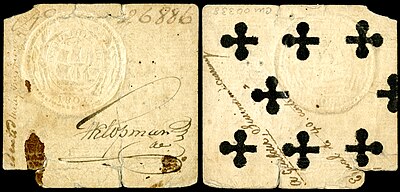Talk:Card money
| This article is rated C-class on Wikipedia's content assessment scale. It is of interest to the following WikiProjects: | |||||||||||||||||||||||||||||||
| |||||||||||||||||||||||||||||||
A fact from Card money appeared on Wikipedia's Main Page in the Did you know column on 1 April 2015 (check views). The text of the entry was as follows:
|
Other links
[edit]- "Wan Bigi Karta", Central Bank of Suriname review of card money
"Ford money"
[edit]The introduction has this red-linked term, which doesn't appear anywhere else in Wikipedia or in a Google search (except in the context of the Ford Motor Company). I think it should probably be 'fiat money' but does anyone know differently? — Preceding unsigned comment added by 132.244.72.5 (talk) 10:15, 1 April 2015 (UTC)
- Twas vandalism, fixed now. — Crisco 1492 (talk) 13:45, 1 April 2015 (UTC)
Any relation between "playing card money" and symbols used on modern playing cards?
[edit]A number of similarities: 1) Fleur-de-lis looks similar to a club. 2) Royalty pictured on cards reminiscent of pictures of specific people on paper money. etc. Terry Thorgaard (talk) 13:42, 1 April 2015 (UTC)
- No sources discuss this explicitly, but I'd doubt it. Suit (cards) tells us that the now-common French playing card suits were present in France in 1480 (long before card money was introduced). Versions of the King, Queen, and Jack can be traced back to around that period as well. — Crisco 1492 (talk) 13:47, 1 April 2015 (UTC)
I also note that the article on playing cards suggests that playing cards were originally paper money. Perhaps this theory should be referenced in the current article. Terry Thorgaard (talk) 13:57, 1 April 2015 (UTC)
- A possibility, though it strikes me as a different subject. — Crisco 1492 (talk) 14:01, 1 April 2015 (UTC)
File:Dutch Guiana-Suriname-1 Guilder (1801) card money.jpg to appear as POTD soon
[edit]Hello! This is a note to let the editors of this article know that File:Dutch Guiana-Suriname-1 Guilder (1801) card money.jpg will be appearing as picture of the day on September 22, 2016. You can view and edit the POTD blurb at Template:POTD/2016-09-22. If this article needs any attention or maintenance, it would be preferable if that could be done before its appearance on the Main Page. — Chris Woodrich (talk) 00:50, 8 September 2016 (UTC)
This playing card from Dutch Guiana (now Suriname), dated 1801, has a face value of one guilder. In that colony, card money was first issued in 1761, initially backed by bills of exchange from the Netherlands; but later it was released unsecured, and inflation was an issue for much of the currency's lifetime, with the value fluctuating wildly until it was replaced with paper money in 1826 and formally discontinued two years later.Card: Government of Dutch Guiana; image courtesy of the National Numismatic Collection
- C-Class Economics articles
- Low-importance Economics articles
- WikiProject Economics articles
- C-Class numismatic articles
- High-importance numismatic articles
- WikiProject Numismatics articles
- C-Class Finance & Investment articles
- Low-importance Finance & Investment articles
- WikiProject Finance & Investment articles
- Wikipedia Did you know articles





